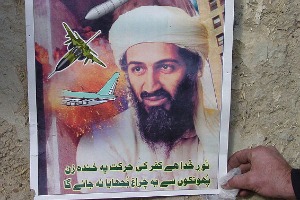Read Karen Greenberg’s previous coverage of the trial of Ahmed Khalfan Ghailani, the first Guantanamo detainee to be tried in a civilian court.
Here we sit for the fourth week in a row, in the federal courthouse in downtown Manhattan. It’s first trial of one of the High Value Detainees rounded up in the war on terror to take place in a federal courthouse. No, we don’t have a bin Laden in custody. Or a Zawahiri. Or even a Khalid Sheikh Mohammed. Instead, we have Ahmed Khalfan Ghailani, a young man charged in connection with the 1998 bombings of the US Embassies in Kenya and Tanzani. Despite the fanfare surrounding the discussion of the KSM case and the Americans’ emotional fearfulness of terrorism, the case, as presented by the prosecution, is mundane, technical, and altogether without drama of any sort—a marked contrast to the pre-trial hearings which centered on the torture of the defendant while in CIA custody.
On Monday and Tuesday, the prosecution presented a series of FBI agents who had examined the crime scenes of both embassies, as well as the dwelling and businesses of the men they allege to have perpetrated the crime. The jury is getting an education in many things during this trial, including forensic studies. The team of experts who examined the residence of the alleged conspirators in Mombasa, Kenya, explained how they donned Tyvex suits so as not to “track anything in or out,” took swabbings to test for chemical residue, bagged items such as a Fanta bottle (now on display in the courtroom), and packed up the evidence for transport to the FBI labs in Quantico, Virginia. One FBI explosives expert explained that he “actually conducted mini-seminars” at the bombing site as he and his colleagues raked through the debris, often with bare hands. He estimated that 1,000 to 1,500 pounds of TNT would explain the size of the explosion that damaged the US Embassy in Nairobi, demolishing a nearby structure and damaging a 22-story bank building across the courtyard.
An FBI metallurgist with a PhD in material science viewed pictures of debris, many only several inches long, and explained that his job is grind each sample flat and use a spectrometer to test the fragments to determine what elements are present in each. He was so precise that he risked disappointing the government: “To be honest,” he said, looking at a tank allegedly used in the bombing, “I’m not sure this is the tank I looked at.”
Interspersed among the federal agents, in part as the chronology warranted, and in part perhaps to break up the didacticism of the forensics experts, individuals from Kenya and Tanzania took the stand. They include welders, businessmen, and neighbors. From them, the jury is learning not only about the case itself, but about the countries where the bombings took place. As each witness takes the stand and is greeted by the prosecutor or defense attorney with “good morning,” the witness customarily answers, through a Swahili translator, “good,” or “very good.” When asked to describe each other, the darkness or lightness of skin is always included, sometimes as “not too dark and not too light.”
As these customs become clear, so have the main names in the prosecution’s narrative: Sheikh Swedan, and Fahim Fahad Mohammed (known as Fahad) seemed to have been involved in meeting in Mombasa, in purchasing the tanks, and outfitting the trucks used in the bombing. Others, such as Swedan’s brother, the brothers Said and Omar Omar, fill in details for the jury, giving the story a greater sense of reality, by describing not only what they observed about the crime and the alleged criminals, but also about life both in Mombasa and in Dar es Salaam.
A mechanic from Mombasa, Micah Kamau Ngugi, wearing an open-necked button down shirt, explained in a soft spoken voice, that his car business was out in the open, which allowed him to watch the Azzan clothing store where Ghailani and the perpetrators allegedly gathered. Talking about Tanzania, Felix John Lukulu, a welder who allegedly procured the gas tanks associated with the bombings, explained how he approached the “cart men” who helped him fill the gas tanks that he claims Ghailani and Fahad asked him for.
Here, as in every piece of the prosecution’s narrative, vehicles take center stage. Fahad drove a Mitsubishi Lancer. Sheikh Swedan drove a Subaru pick-up. In Mombasa, a Nissan Sunny Saloon often came into the story, as did a Datsun pick-up. A Toyota Dyna allegedly carried the explosives for the Kenyan bombing. In Tanzania, it was a Suzuki Samurai.
In this mass of details—often redundant, as the judge commented in the absence of the jury—the prosecution continues to run the risk of losing Ghailani. In place of a focus on the defendant—so far—we have repeated proof that there was an explosion and that the elements of the crime—the cars, the gas tanks, the refitting of the trucks —are apparent. Ghailani definitely comes in and out of some of the scenes described. The Fanta bottle is said to have his fingerprints on it, and he was present in the house at Mombasa, where the defense argues he was merely helping Fahad out with the store.
There is essentially one picture of him and it appears periodically, but not with the frequency of the photographs of Swedan and Fahad. Some days, he makes almost no appearance at all. Ghailani is there, somewhere, but the story and its main characters may come to loom much larger than the defendant who has been brought to the United States as the sole representative of the al Qaeda terrorism that has consumed so many for so long.
Research for this post was contributed by Center on Law and Security researchers Christine Yurechko and Lisa Sweat.




